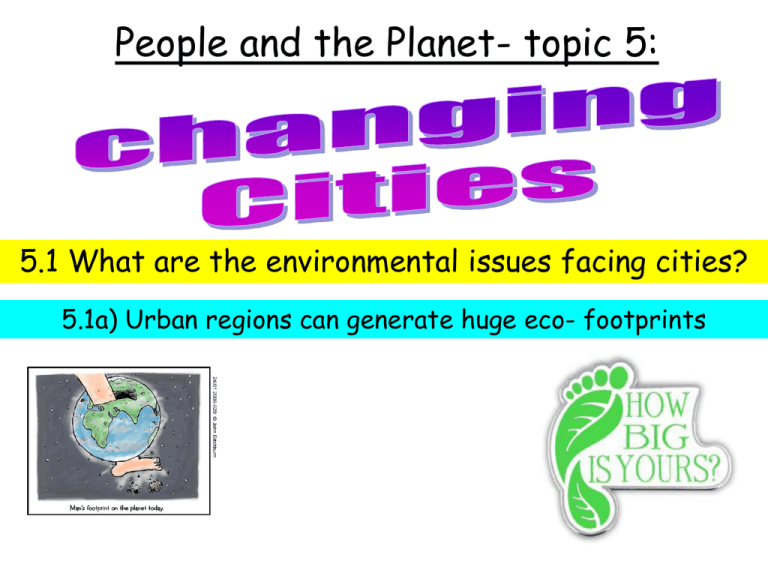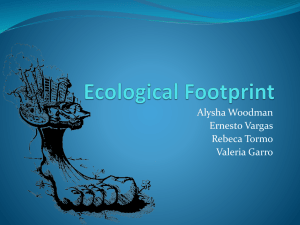Lesson One: Why do eco footprints vary?
advertisement

People and the Planet- topic 5: 5.1 What are the environmental issues facing cities? 5.1a) Urban regions can generate huge eco- footprints Large graphic Our modern lives use lots of resources. All resources ultimately come from the natural environment. This lessons looks at variations rates of consumption amongst different communities. Coming up • • • • • • What is an eco-footprint? What contributes to an eco-footprint? How and why to eco-footprints vary? Case study: Winchester v Salisbury Case study: Variations across London Case study: Global variations By the end you will be able to • Define what an eco-footprint is • Describe and explain variations in ecofootprints at different scales Urban regions and their eco- footprints What is the Ecological footprint of a Country? The Ecological Footprint of a country is defined as the land and natural resources required to provide the raw materials on which the country along with its population feeds, and process the waste products it produces. • We use the natural environment as a SOURCE- to obtain things for our needs • We also use as a SINK- to dispose of all our waste products • These SOURCES and SINKS represents the amount of land, water and air (BIPRODUCTIVE AREAS) needed to support our lifestyles • This is expressed in the measurement GLOBAL HECTARES (GHA) Task: Define “Source” and “Sink” What is in our footprint? What sources do we use in order to be able to live in London? What sinks do we use in order to be able to live in London? Use page 205 in the textbook to help. What is in our footprint? Our footprints now extend far beyond places we live in as we no longer produce, consume and dispose of everything we need in our local area. These components make up an eco-footprint1) Food we eat 2) Transport we use 3) Housing we live in 4) Entertainment and leisure services 5) All consumer goods- clothes, electricals and all energy it takes to produce and transport it 6) Infrastructure- water and power supplies, health and education services, transport network improvements 7) Public services- resources used by councils to support our lifestyles- refuse collection, highway and park maintenance, street furniture, etc Eco-footprint component How it contributes to a footprint Food you eat e.g. Food is imported from overseas. Chemical fertilisers help food grow Transport you use Housing Entertainment and leisure services Consumer goods Infrastructure Public services How this impacts your individual ecofootprint I eat citrus fruit from Spain Why do eco-footprints vary? Salisbury Winchester Why do eco-footprints vary? Salisbury and Winchester are two small cities in the south of England. Salisbury has a population of 45000, whilst Winchester has a population of 40000. Salisbury and Winchester are just 80km apart but have very different eco-footprints City Planets Footprint (global hectares) Salisbury 2.79 5.01 Winchester 3.62 6.52 Which city has the smallest footprint? Can you suggest reasons for the difference?. Why do eco-footprints vary? Place the statements into the correct column. Unemployment is low Cycling is popular. House prices are lower. Unemployment is low People commute long distances to work. Income is higher Salisbury Winchester Why do eco-footprints vary? Put each statement in the correct column. For each statement explain how it impacts on the eco-footprint of the city. Salisbury Winchester House prices are lower. This affects the ecofootprint because Income is higher. This affects the eco-footprint because Cycling is popular. This affects the eco-footprint because People commute longer distances to work. This affects the eco-footprint because Unemployment is low This affects the eco-footprint because Unemployment is low This affects the eco-footprint because Why do eco-footprints vary? Check your answers. Winchester has more commuters that travel longer and further to work therefore use cars increasing their CARBON FOOTPRINT (an aspect of the eco footprint). more and in Salisbury people cycle/ walk to work more. People have higher income in Winchester so can afford to spend more on more things. House values are higher in Winchester so can afford to spend more on more things. Both cities have high employment rates, meaning they have income to spend on material possessions London’s eco-footprint London is 44th on the WWF list out of 60 towns and cities London’s total footprint extends over an area twice the size of Britain and is equal to the size of Spain. Not all of London has a large print- How do footprints vary across London? London’s eco-footprint Can you explain the variations in London’s eco – footprint? % of low paid residents . Eco footprint Eco- footprints around the World Think: how will eco – footprints vary between countries? Justify your answer. Eco- footprints around the World Lower Income Countries (LEDC)- tend to have smaller ecofootprints due to lifestyle differences and lower levels of consumption in general Higher Income Countries (MEDC)- tend to have higher ecofootprints as they have materialistic wealth, and therefore consume more. Task• Look at the graph and table on page 207 of textbook • Is there a relationship between a country’s HDI rank and their eco-footprint? • Which countries are anomalies (don’t fit the normal pattern?) why? Why do you think the UK has a high eco footprint whilst Kenya has the low eco footprint? Use the cards on your table to identify the reasons for this. Summarise the answers in your exercise book Why do you think the UK has a high eco footprint whilst Kenya has the low eco footprint? Check your answers DEVELOPED eg UK 5.3 ha per person DEVELOPING eg Kenya 1.5ha per person People in the UK consume more as they People consume less as they have lower are more affluent eg: incomes (less affluent) Buy consumer goods eg CD’s; fridges etc. Consume fewer goods as they have lower Which consume resources; consume incomes (GDP is less) energy in production; transport and use. Buy imported foods eg coffee; exotic Many grow their own food fruits etc which increase food miles. Own and run more cars which consume oil Few people own and run cars. Walk and and contribute to air pollution as well as use bicycles. CO2 contributing to global warming Spend money on foreign holidays which Only the small wealthy minority can generates more CO2 emissions from afford foreign holidays aeroplanes People in the UK generate more waste Electricity is expensive and consumption from consumer goods and consumption of levels are low especially in rural areas. for eg electricity Overview • There are many individual components that make up our eco-footprints, such as where our food is from, how much we own and who makes it, which services we have in our local area, how we dispose of our rubbish and how much rubbish we create. • The world tends to see a pattern, with more highly developed countries having higher ecofootprints, although within all countries ecofootprints vary from place to place. Practice Question • Using examples, explain how and why different cities have different ecofootprints (4 marks) To finish What is the likely eco-footprint of people who: • • • • Take foreign holidays Play “I spy” each evening Own an allotment Commute for 1 hour per day. Explain your reasons










